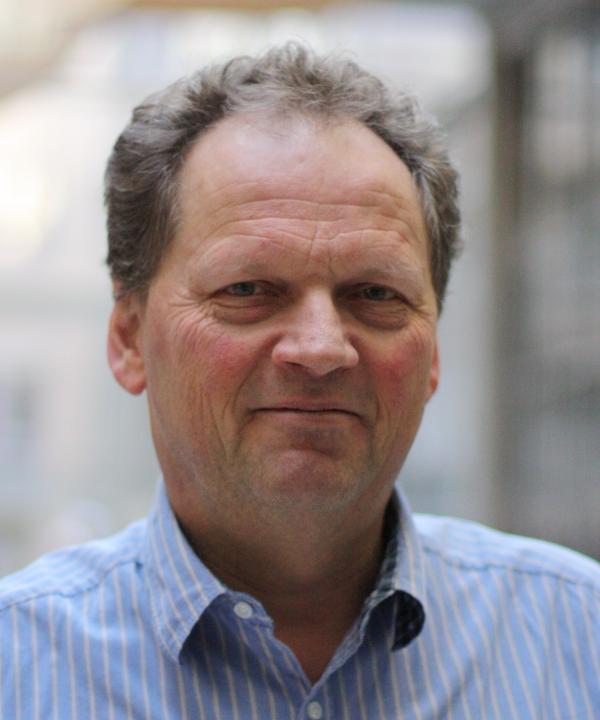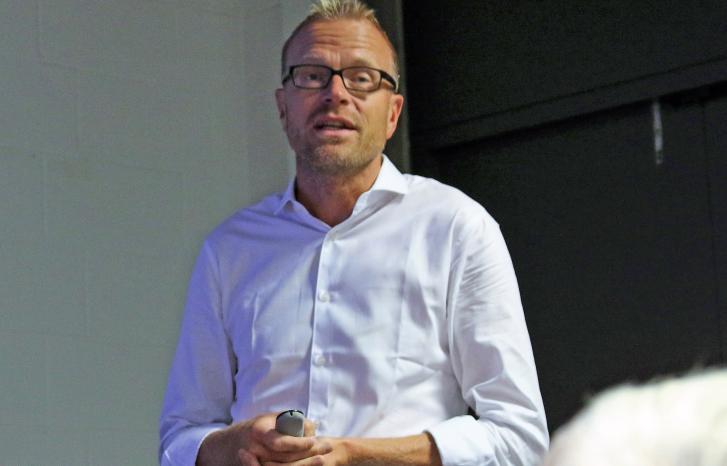In collaboration with researchers Ulla-Britt Lilleaas and Beate Sløk-Andersen, Dag Ellingsen has co-authored an article published in the last issue of Journal of Gender Research (Tidsskrift for kjønnsforskning), which is a special issue about #metoo. They have studied humour in the Armed Forces, and demonstrate how humour can function both as a means for team spirit and for exclusion among the conscripts.
Difficult part of #metoo
In their study, the researchers have explored the various forms of humour that are in play in the compulsory military service of the Norwegian and Danish Armed Forces.
“The most important work that we do is to address humour as something difficult, and at the same time attempt to say something about what kind of humour is OK and what is not. It has been important for us to try to draw a line there,” says Ellingsen, who is researcher II at Oslo Metropolitan University (OsloMet).

“Of course we see the need for humour in an otherwise often fairly challenging everyday life, with hard training and unfamiliar situations. Humour is obviously necessary in order to take the load off. But if this relief is at the expense of other people, it becomes unacceptable.”
Several of the types of humour that the researchers have found are characterised by sexist comments primarily about women, but also about queer people. They have studied the humour in light of #metoo.
“It reflects the most difficult part of #metoo. In many other cases, we are talking about obvious abuse of power. Many of the cases that sparked off the metoo movement were alleged or convicted rape cases, but this is a whole different terrain.”
Ellingsen explains that people experience the humour very differently.
“Some – and the male conscripts in particular – say that they find the humour very funny, and that it is an important part of the life they live. Others do not like it at all.”
“We wanted to distinguish between the humour that is OK in the sense that everyone is in on it and it helps strengthen the team spirit – and the humour that clearly says to certain people that ‘you do not belong here’ or ‘you are worth less than others’. This last type of humour is normally directed only at one sex.”
Women are highly under-represented in the Armed Forces. Particularly at the higher levels of the hierarchy.
“One characteristic of the Armed Forces is that twenty-five to thirty per cent of the conscripts are women, but from the lower hierarchy of officers and up, there are much fewer women. It is still very much a male bastion, and this becomes more and more obvious the further you get into areas where they talk about ‘having balls’, such as among the commando soldiers.”
Culture changes must start from above
In their article, the researchers conclude that changes within the organisation must happen from the top, among other things because much of the humour is promoted by leaders at the lower levels.
“Much of the humour is transmitted by the lower-level officers, particularly from the instructors, in the form of mnemonic rules that play upon women and gender and what is considered gay sex,” says Ellingsen.
“Conscripts wonder what applies and what does not in their new setting, and most of them are eager to master the situation. It is therefore unfortunate that the officers are the ones who promote this humour to the recruits through their instruction.”
Several aspects shape this culture, according to the researchers. For example, the fact that the conscripts are often placed within a limited area and have little contact with the rest of the world.
There is very little self-deprecating humour in these circles. The guys do not tell humour at their own expense, it is all about women.
“They can often sit and listen to the humour for hours. There is very little self-deprecating humour in these circles. The guys do not tell humour at their own expense, it is all about women. From bragging about one’s own alleged conquests to telling jokes about how women in reality belong in the kitchen to sexist jokes,” he explains.
“Of course you can endure that every now and then. But what we hear, both from the Police Force and from the Armed Forces, is that some people sit for hours and tell these stories and jokes.”
The researchers are convinced that the leadership play an important role in overcoming the problem.
“It takes a reliable leadership that can tell their subordinates in a convincing manner that they do not want this kind of humour in the Armed Forces.”
“And it is essential that the leadership themselves do not have any skeletons in the closet. It is impossible to be credible if you have done similar things yourself. The Armed Forces, but also the Police Force, are organisations in which many people know a lot about the others.”
‘Male-bonding atmosphere’?
Lilleaas and Ellingsen write about what they refer to as ‘male-bonding atmosphere’ in their article. People have different experiences of this depending on whom you ask.
“You have guys saying that ‘this is our version of girls’ intimate talk, and we also want to be close with each other’. At the same time, the girls say, ‘no, this is just bragging and nonsense, and male chauvinistic talk’,” says Ellingsen.
‘Male-bonding atmosphere’ revolves a lot around bragging about one’s own sexual conquests, according to Ellingsen. He suspects that the stories are not rooted in reality.
“The Ungdata survey is a survey of pupils at lower and upper secondary schools conducted by the Norwegian Social Research Institute NOVA, which asks youth about their sexual experiences. And hardly anyone is even close to the types of experiences that these guys brag about.”
“Perhaps it works for boosting one’s self-esteem, but it is not much fun for the girls to listen to. And in many of the contexts about which we write or in which we have been, people are together for a long period of time. There is little space, and what you are able to do is very limited. To some people this type of humour then becomes very intrusive, if not also offensive.”
The researchers wonder where the phenomenon ‘male bonding atmosphere’ actually comes from. They have heard the term in connection to the Norwegian ‘Russ’ celebration, where final-year pupils in their final spring semester celebrate that they have attended thirteen years of school They wear particular coloured overalls, and some groups of either girls or boys have their own bus or van in which they party and drive around.
“We had the impression that some, and particularly people from Oslo, were well familiar with the concept. Others said that they had first heard about it in the Armed Forces.”
“’Male-bonding atmosphere’ obviously serves more than one purpose depending on whether you are the receiver or the transmitter, and your gender. We wish we knew more about this,” says Ellingsen.
Want to keep the women
Despite the fact that many women leave the Armed Forces after finishing their compulsory military service, Ellingsen experiences that the Armed Forces acknowledge the benefit of having more gender balance in the organisation.
“They get many highly qualified women with the compulsory military service. Some of the officers say that it is a strength for the Armed Forces to have women there. Particularly for planning, logistics and keeping things in order. The girls are both better at this and more mature.”
An important point is that if you want to advance within the system, being operative and out in the streets is significant for your further career.
The Armed Forces consider the women’s role important, and take measures to distribute their competence into various disciplines, according to Ellingsen. For instance, they use surveys and research, but also concrete measures as part of the education.
“The Armed Forces do some quite impressive things. They have conducted special training of women who want to become paratroopers and commando soldiers, and they have spent much time and money on this. This proves that it is possible given the right type of training, and this is important politically, both in reality and symbolically,” he says.
“Neither police work nor military work is what it used to be, when the traditional soldier were supposed to carry heavy loads, walk long distances and use arms. Many other important qualifications are needed, such as IT competence.”
The Police Force is lagging behind
The researchers see a big difference between the Armed Forces and the Police Force in their attitudes to gender balance.
“In my opinion, we have received relatively clear messages from the leading officers of the Armed Forces that they were not happy with the situation following the MOST survey that the Armed Forces initiated and conducted. The published findings from the Armed Forces demonstrate a kind of openness that we have not seen from the Police Force. The Police Force truly needs a thorough survey of their metoo problems in order to have a good starting point for measures and research,” says Ellingsen.
“The last admission to the Norwegian Police University College had a share of fifty-three per cent women. Many competent women with strong physics and psyche and good grades from school. They then enter an organisation in which much of the ‘real’ police work is still highly male dominated, like being out in the streets and having the right to bear arms when required.”
According to Ellingsen, the uneven work distribution within the Police Force is a challenge that is propagated further up in the hierarchy of the organisation.
“The question is how long this can continue. An important point is that if you want to advance within the system, being operative and out in the streets is significant for your further career.”
Coarse humour, confirmation and trust
Some of the humour that is considered harassing is very coarse. The researchers heard this both among the Norwegian and the Danish recruits.
“The humour is extremely perverse, and those involved try to overbid each other in the sense that they try to tell a story or a joke that is twice as perverse as the joke that was told before. I think this is how the male bonding atmosphere works too,” says Ellingsen.
“They affirm each other. I come up with a joke that is a bit over the line, and the guys think it is great. Then someone else overbids that, and there we go. It is a way of showing each other what is accepted.”
The acceptance for this kind of humour is wide because it is difficult to protest.
Among those who replied ‘no’, this is not sexual harassment, there was a larger amount of men and of higher age.
“We know this from our own interviews. You will be regarded as a prude whiner and killjoy. Killjoy is a term that our Danish co-author uses a lot. You are told that you are a prude, and ‘if you can’t take this, how will you be able to handle a war situation?’” says Ellingsen.
“We consider this to be both a problem for the work environment and a signal of limited inclusion. It signals that ‘here the guys are in charge and you are here on our terms’.”
According to the researchers, team spirit is a significant aspect in this context, which again is closely connected to security.
“Being surrounded by people you trust and that you feel recognised by is probably very important in order to literally want to go to war with them. At its most extreme, all kinds of security work is ultimately about whether you want to risk your life and health for others, and with others.”
“Our Nordforsk project is very much about this: What does it mean that we have obtained a more gender equal police and military? Does it mean that the organisations as such become better? We believe so. But we are also quite certain that it requires mutual trust and respect in order to achieve this.”
Humour is perceived differently
Mona Bråten, senior researcher at the FAFO Research Foundation, agrees that it is important to focus on leadership in order to obtain changes in a humour based sexually harassing culture within the organisation. She has written an article published in the Journal of Gender Research about sexual harassment in various parts of the working life viewed in light of #metoo.

Bråten has asked creative and performing stage actors whether they consider various situations as sexually harassing or not. One of the situations they were asked to consider was ‘making jokes with sexist content without knowing for certain whether it is appreciated’.
“Here, forty-seven per cent responded that ‘yes’, this is sexual harassment, twenty-nine per cent replied ‘not certain’ and twenty-three per cent said ‘no’, this is not sexual harassment. We also found some very interesting differences between gender, age and professions,” she says.
“Among those who replied ‘no’, this is not sexual harassment, there was a larger amount of men and of higher age. There were also differences between the various professions. This illustrates that both gender and age are significant factors when considering whether jokes and humour with sexual content are considered as sexual harassment or not,” Bråten explains.
Those who speak up
Both in their article and in previous studies, the researchers use the term masculine solidarity about the men who speak up when they observe unacceptable behaviour among their fellow soldiers.
“Who are the guys that speak up?”
“We do not know these guys in detail. But within the literature about hegemonic and dominating masculinity, ‘the bystander’ is often referred to. In the cases where boys harass girls, they are often dependent on others that stand by and accept what goes on, and laugh at it. If the cheering disappears, these guys have a problem,” Dag Ellingsen explains.
“If the others say that ‘this is taking it too far, we cannot accept this any longer’, it will have an entirely different effect.”
The researchers describe a female conscript who told a fellow soldier about unacceptable behaviour among her roommates, whereupon he reported the case to an officer higher up in the hierarchy.
“What was special in this particular case was that the affected girl was highly competent and respected. Some of the guys reported what was going on, and the leadership intervened. But we do not know whether she would have experienced the same solidarity if she was not considered as competent.”
Translated by Cathinka Dahl Hambro.
- The article and parts of the research is funded by NordForsk.
- The studies are based on fieldwork conducted among Norwegian and Danish conscripts.
- Lilleaas and Ellingsen have talked to people both at the bottom and at the top of the hierarchy in the Armed Forces and the Police Force in Norway – a total of more than 90 informants. The empirical data were collected during the period between 2012 and 2019.
- Beate Sløk-Andersen has observed the Danish Armed Forces from the inside, herself being a conscript for four months. In addition, she conducted almost 40 interviews with officers, conscripts and people with other relations to the soldiers.



